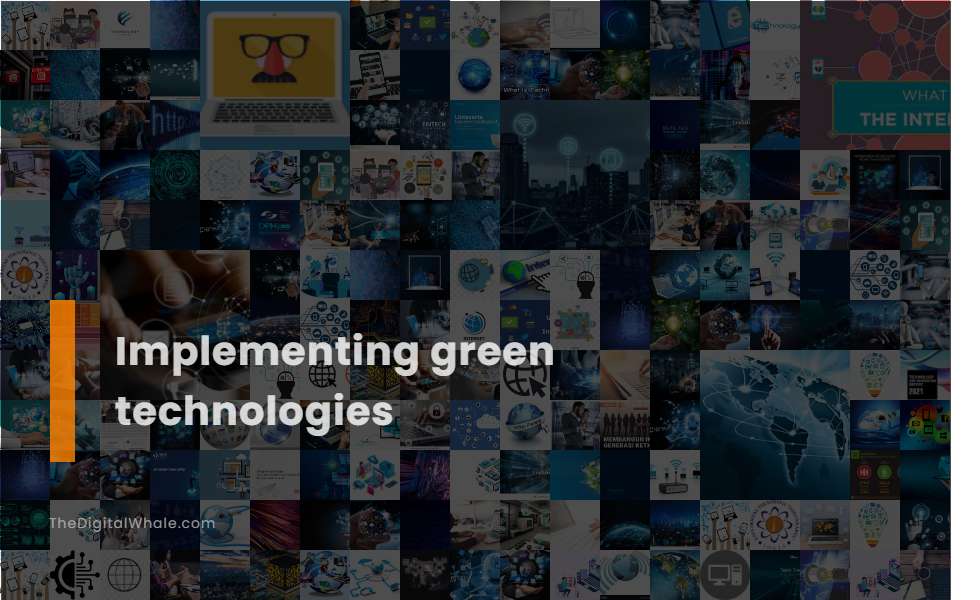Implementing Green Technologies
How can you implement green technology in your company? What is the most efficient solar energy conversion technology? Let's find out more about Implementing Green Technologies.

Biomimicry: Mimicking natural processes for sustainable solutions.
Biomimicry involves mimicking natural processes and patterns to create sustainable solutions, such as using compost-like mixtures of worms and vegetable scraps for hydroponic fertilizers, and replicating the designs of beehives, spider webs, and termite mounds to address issues like food security, water scarcity, and climate change. This innovative approach is also crucial in sustainable design, where bio-based materials like bamboo and mycelium are used, and natural systems such as termite mounds for passive cooling and honeycombs for energy-efficient structures are mimicked to reduce environmental impact and enhance resource efficiency.
Molten Salt Energy Storage: Using salt for heat storage in renewable energy systems.
Molten salt energy storage, such as MAN MOSAS, uses liquid salt heated to high temperatures (up to 570°C) to store thermal energy, which can be converted into electricity using steam turbines. This technology is highly flexible, economical, and suitable for integrating renewables, stabilizing the grid, and retrofitting conventional power plants. It stands out as a key solution for long-duration energy storage and decarbonized power generation. For more information, visit the MAN Energy Solutions website to explore their offerings in this innovative field.
Artificial Photosynthesis: Technological mimicry of photosynthesis for energy production.
Artificial Photosynthesis is a chemical process that mimics natural photosynthesis, using sunlight to produce energy in the form of fuels such as hydrogen, methane, formic acid, or methanol. It involves components like light-harvesting complexes, proton-coupled electron transfer, and redox catalysis, aiming to provide a clean, sustainable, and efficient source of energy. For more detailed information, visit the Artificial Photosynthesis webpage.
Carbon Capture and Storage: Capturing and storing CO2 emissions from industrial sources.
Carbon Capture and Storage (CCS) is a pivotal process for reducing carbon emissions, entailing three crucial steps. Initially, it involves capturing CO2 emissions from industrial sources, including power plants and the production of steel and cement. Following this, the captured CO2 is transported through pipelines, ships, or road transport methods. Finally, it is stored deep underground in geological formations, such as saline aquifers or depleted oil and gas reservoirs, ensuring its safe and permanent sequestration. This innovative method is thoroughly elaborated on the National Grid website, underscoring its significance in industrial emission reduction strategies.
Electric Vehicle Propulsion: Using electric vehicles to reduce fossil fuel emissions.
Implementing green technologies in electric vehicle propulsion, such as Fuel Cell Electric Vehicles (FCEVs) and Battery Electric Vehicles (BEVs), significantly reduces fossil fuel emissions. FCEVs produce only water vapor and warm air as emissions, while BEVs eliminate tailpipe emissions entirely and offer higher efficiency compared to conventional internal combustion engine vehicles, leading to substantial reductions in lifecycle emissions. For more information, you can explore the benefits and mechanisms of Fuel Cell Electric Vehicles.
Related:
What is the minimum effective use of technology in the workplace? What are some ways technology can increase workplace productivity? Let's find out more about The Role of Technology In Workplace Productivity.
Smart Meters: Reducing energy consumption through smart meter technology.
Smart meters reduce energy consumption by providing real-time data on energy usage, enabling households to adjust their habits and save an average of 3.4% on electricity and 3.0% on gas. This technology promotes energy efficiency and encourages behavioral changes in households. For more in-depth insights into how smart meters impact energy management, visit the Behavioural Insights Team's blog on the topic.
Waste-Water Electricity Generators: Generating electricity from wastewater using microbial fuel cells.
Microbial Fuel Cells (MFCs) generate electricity from the biodegradation of organic materials in wastewater, offering a renewable energy source that simultaneously treats wastewater, reduces sludge production, and is less sensitive to temperature changes. This makes them a promising green technology for sustainable energy and water management. To delve deeper into their potential applications and benefits, explore the detailed research and findings at Frontiers in Energy Research.
Green Building Technologies: Energy-efficient design, green roofs, and sustainable materials in construction.
Green building technologies focus on energy-efficient design through methods like creating net-zero or net-positive buildings, controlling embodied carbon, and using geothermal, solar, and wind energy. Additionally, techniques such as green roofs, resilient and passive design, and the use of sustainable materials like bamboo, hempcrete, and recycled steel are integral to these technologies. For more insights into these methods, visit Autodesk Design & Make for comprehensive articles on implementing these sustainable practices effectively.
Geothermal Heat Pumps: Using earth's warmth for heating and cooling homes.
Geothermal Heat Pumps utilize the constant temperature of the earth, typically between 40°F-70°F (4.5°C-21°C), to efficiently heat and cool homes by exchanging heat through a ground heat exchanger. This method offers a highly efficient and renewable energy solution. For more detailed information, you can visit the Department of Energy's Geothermal Heat Pumps page.
IoT in Green Technology: Leveraging IoT for sensor-based solutions and renewable energy management.
Leveraging IoT in Green Technology involves using IoT sensors and analytics to optimize renewable energy sources like solar and wind power, reduce emissions, and conserve energy and resources, thereby promoting sustainable industrial practices and enhancing environmental efficiency. For further insights into the market opportunities within this domain, you can explore more details on the Markets and Markets website.
Related:
What are some pros and cons of telecommuting? What are some of the pros and cons of working from home? Let's find out more about The Pros and Cons of Telecommuting.
